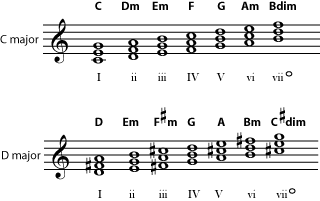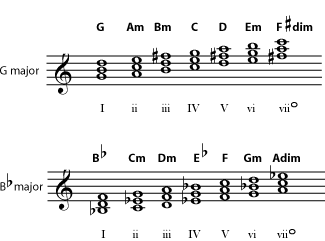| << Chapter < Page | Chapter >> Page > |
It sounds like a very technical idea, but basic harmonic analysis just means understanding how a chord is related to the key and to the other chords in a piece of music. This can be such useful information that you will find many musicians who have not studied much music theory, and even some who don't read music, but who can tell you what the I ("one") or the V ("five") chord are in a certain key.
Why is it useful to know how chords are related?
Any chord might show up in any key, but some chords are much more likely than others. The most likely chords to show up in a key are the chords that use only the notes in that key (no accidentals ). So these chords have both names and numbers that tell how they fit into the key. (We'll just discuss basic triads for the moment, not seventh chords or other added-note or altered chords.) The chords are numbered using Roman numerals from I to vii.

Write and name the chords in G major and in B flat major. (Hint: Determine the key signature first. Make certain that each chord begins on a note in the major scale and contains only notes in the key signature.) If you need some staff paper, you can print this PDF file

You can find all the basic triads that are possible in a key by building one triad, in the key, on each note of the scale (each scale degree ). One easy way to name all these chords is just to number them: the chord that starts on the first note of the scale is "I", the chord that starts on the next scale degree is "ii", and so on. Roman numerals are used to number the chords. Capital Roman numerals are used for major chords and small Roman numerals for minor chords . The diminished chord is in small Roman numerals followed by a small circle. Because major scales always follow the same pattern, the pattern of major and minor chords is also the same in any major key. The chords built on the first, fourth, and fifth degrees of the scale are always major chords (I, IV, and V). The chords built on the second, third, and sixth degrees of the scale are always minor chords (ii, iii, and vi). The chord built on the seventh degree of the scale is a diminished chord.

Notification Switch
Would you like to follow the 'Introduction to music theory' conversation and receive update notifications?